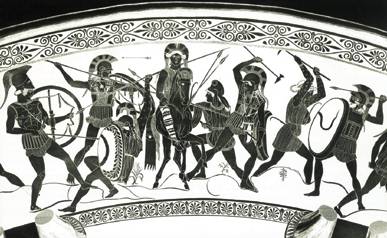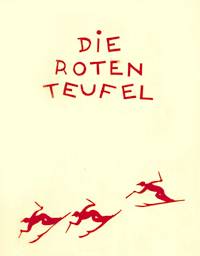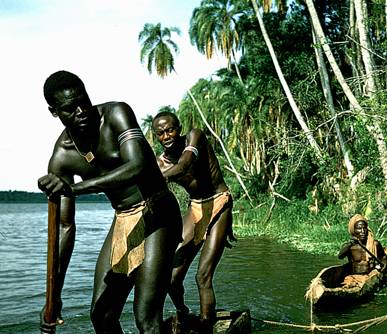

| Leni Riefenstahl has written many interesting outlines, which
could partly not have been realized due to the war, and other
difficulties she mentions in her memoirs. Among those are even
projects which would have been pioneering in film art. The film
version of »Penthesilea« after Heinrich von Kleist for example,
or »Die roten Teufel« and »Friedrich und Voltaire« where Jean
Cocteau wanted to play the parts of Friedrich and Voltaire, but
also the films about »Van Gogh«, »Die schwarze Fracht« a film
about modern slave trade,»Der Tanz mit dem Tod« or »Drei Sterne
am Mantel der Madonna« written upon request of Anna Magnani, had
been unusual subjects. As early as in 1926 two film subjects Leni Riefenstahl had been especially enthusiastic about could not be realized although the Ufa had already made good progress with the preparations for both films. In both scripts, Dr. Fanck had created fascinating parts for his principal actress. The Ufa stopped its preparations because of a quarrel between Luis Trenker and Dr. Frank, and commissioned Dr. Frank instead of these two very expensive films to present new suggestions for films, which should cost half as much. Leni Riefenstahl had been desperate, because, as she said even after years, these were the nicest film subjects Dr. Fanck had ever written. The titles were »Wintermärchen« and »Die schwarze Katze«. The content of the »Wintermärchen«: An orphaned brother and sister living in the town inherit from their grandmother a small hut in the mountains. During a snowstorm the small four years, old boy is lost, and completely exhausted he falls asleep under a fir tree. While his seven years old sister is searching for him despairingly, the child has a fantastic dream offering the director Dr. Fanck the opportunity to wallow in unique pictures. Especially the contrast had been visually attractive in this subject, for the plot took place in the sombreness of the Ruhr area and in the sunlight of the glittering ice and snow scenery of the Sudeten Mountains. An enchanting plot - half reality and half a fairy tale. Die schwarze Katze: Dr. Arnold Fanck's best script. A war film in the Dolomites after an experience of our cameraman Hans Schneeberger. The big explosion on the Casteletto is the film's main subject. During the world war, Schneeberger as a lieutenant together with 60 men kept the position until the last moment, then it was blown up and all of them were buried. He could be rescued out of the ruins together with eight men only. The mountain guide's daughter is »Die schwarze Katze« in this film, called so because of her bold climbing skills. It was a wonderful part for Leni Riefenstahl. Again, this film project failed due to Luis Trenker. He made a tomcat out of the she-cat, took possession of Dr. Fanck's script, and to Dr. Fanck's and the Ufa's dismays he himself started to make the film - an unbelievable plagiarism. Since Dr. Fanck did not want to take the burden of a lawsuit, this bad matter had been settled out of court. Trenker called his film »Berge in Flammen«. It was his first film and became very successful. Dr. Fanck and Trenker parted from now on. However, not only Dr. Fanck had been unlucky at that time, Leni Riefenstahl was it too. It had been her desire since quite a long time to be able to work under the direction of a very good movie director. Well, for Dr. Fanck the principal actors had been the mountains. Now she got this chance for the first time. The Ufa engaged her; it had been a top part for an actress; »Mademoiselle Docteur«, the authentic story of a female spy who had been working for the German defence during World War I. Leni Riefenstahl was overjoyed. Frank Wysbar had been signed on as the director, one of her favourite directors at that time, and Gerhard Menzel as the scriptwriter. However, the luck did not last for long. A messenger delivered to her the bad news that unfortunately the Ufa will not make this film, for the Wehrmacht ministry would grant no more permissions for spy films giving the reason that a spy film would allow too many insights into this field. Instead of having the chance to play the »Mademoiselle Docteur« Leni Riefenstahl deeply despaired had to produce for Hitler the Reich Party Congress film »Sieg des Glaubens« followed by »Triumph des Willens«. Through these commissioned films she was forced to dispense with her work as an actress for many years.  As late as in 1938 Leni Riefenstahl believed that after years of hard work, she had just finished her films about the Olympic games, a wish could come true, that she would be able to create a great part as a movie actress after all. It was »Penthesilea« the last Queen of the Amazons brilliantly described by Heinrich von Kleist. Her films had been so successful that she was able to produce this gigantic piece of film herself. Marshal Balbo the Italian governor of Libya provided to her 1,000 white Arabian stallions. The battle scenes should have been shot in the Libyan desert and in the sand dunes on the island of Sylt. In the spring of 1939, Leni Riefenstahl let a large number of young sportswomen be trained as Amazons. She herself learned to ride a horse without a saddle too. The battle of the genders had not been planned as a filmed theatre play, to be more precise von Kleist's poetry language should have formed a whole together with stylised picture visions. She as the director prepared the shootings, engaged the actors and the staff, selected Lipizzaner and Great Danes for the film. However, the beginning of the war on September 1st 1939 destroyed this unique film project too. Later not realised film projects: Die roten Teufel  This skiing film is varying the Penthesilea theme as a comedy - the battle of the genders on skis. The colours red, blue and yellow were planned to have a dramaturgic function - a new creation on film. The world's best male and female skiers had been engaged for this film as well as Vittorio de Sica and Brigitte Bardot too yet still unknown at that time. The Herzog film hire company had taken over the financing. However, a few days before the start of the shootings so serious libels and attacks had been published in the papers that the Herzog film hire company was forced to cease the work. The following projects too could not be realised. Vincent van Gogh A film about the artist's passion, about genius and insanity. It was planned to shoot the realistic plot in black and white, in colour only those shots, which show how, von Gogh is painting and how his paintings are created. Friedrich der Große und Voltaire The unusual amicable relationship between the Prussian King and Voltaire had been the subject. Jean Cocteau planned to play both parts - a cinematic sensation. Afrikanische Symphonie Africa is shown from four different points of view: from the realistic one of the reporter, from the surrealist-romantic one of the artist, the adventurous one of the hunter and the ethnological one of the scientist. Ewige Gipfel A documentary film about four historic first ascents in four different countries. Produced after the actual event. In Italy the »Three battlements«, in Switzerland the »Eiger's north face«, in France the »Montblanc« and in India the »Mount Everest«. Sol y Sombra (sun and shade) A documentary film about Spain's religious, artistic and architectural diversity. The river Nileer A documentary film about the life and the cultures of the various primitive peoples living on the banks of the river Nile. Die Schwarze Fracht  A film about modern slave trade after a book by Otto Meissner and documents of the Anti-Slavery Society in London. A scientist is searching for her husband missing in Africa and gets involved in the modern slave trade. Alone among the Nuba A documentary film about the Nuba's life. In the winter of 1964/65 Leni Riefenstahl is shooting the wrestling bouts of the Nuba in Tadoro, the ritual activities, the dances and the everyday life. During the processing the new special speed ER material is spoiled. It was impossible for Leni Riefenstahl to repeat these shots for civilization had destroyed the old ritual customs and conventions of the Nuba. She could not finish this film. Coral reefs - impressions under water A documentary film about the fascinating world under water. Leni Riefenstahl had been filming for several years at some of the world's most beautiful reefs. She says: I do not need a plot, the pictures shall tell the story. For reasons of health, she has not been able to finish this film so far. Photos: Archives Riefenstahl Copyright © 2000-2001 All Rights reserved. Alle Rechte vorbehalten. Leni Riefenstahl Produktion Copyright © 2000-2001 All Rights reserved. Alle Rechte vorbehalten. www.maldonado.de info@leni-riefenstahl.de |